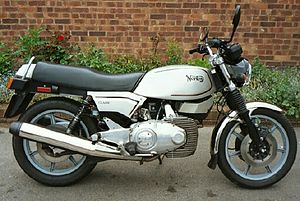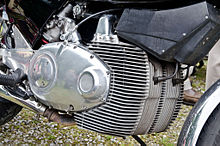Norton Classic
 | |
| Manufacturer | Norton Motorcycle Company |
|---|---|
| Also called | P43 |
| Production | 1987 |
| Engine | 588 cc (35.9 cu in)air-cooledtwin-rotorWankel engine |
| Transmission | duplex primary chain, 5-ratio gearbox, single-row final drive chain |
| Wheelbase | 1,486 mm (58.5 in) |
| Related | Norton Interpol 2,Norton F1,Norton Commander |
TheNorton Classicis a rotary-enginedmotorcyclebuilt in 1987 byNortonas aspecial editionof just 100 machines.
Engine development
[edit]The Classic used anair-cooledtwin-rotorWankel enginethat had been developed byDavid GarsideatBSA'sUmberslade Hallresearch facility.[1][2][3]Garside, who had been impressed by theair-cooledsingle-rotorFichtel & Sachsengine in theHercules motorcycle,installed a bought-in F&S engine into aBSA B25 'Starfire'frame as a "proof of concept". This proved reliable and smooth, but under-powered. Having obtained alicencefrom Felix Wankel in 1972, Garside then created a prototype twin-rotor engine (with F&S rotors) which doubled the capacity of the earlier test "mule". This twin-rotor engine was installed in a BSA A65 frame.[4]
Wankel engines run very hot,[5]so in addition to its very deep cooling fins Garside gave this air-cooled motor interior air-cooling. Air was drawn through a forward-facing filter situated to provide aram aireffect. This air passed through the interior of the rotors and then into a large pressed-steel plenum before entering the combustion chambersviatwin carburettors.[6]The plenum (which doubled as the bike'ssemi-monocoqueframe) enabled the transfer of much of the heat to the surrounding atmosphere. The carburation process further reduced temperaturesviatheprocessof evaporation. Even so, at 50 °C the fuel-air mixture was still hotter than ideal, and the engine'svolumetric efficiencyremained somewhat impaired. The eccentric shaft's main bearings and the inlet manifolds were fed by oil-injection lubrication, and the fuel-air mix also carried residual mist of oil from the interior of the rotors, which helped to lubricate the rotor tips.[7]

Engine geometry
[edit]Source:[8]
- Generating radiusR = 71 mm
- Eccentricitye = 11.6 mm
- Equidistancea = 0.5 mm
- Rotor housing widthB = 68.2 mm
- Chamber displacementVk= 294 cm3
- Compression ratioε = 9.2:1
The Classic motorcycle
[edit]
While its engine was revolutionary, in other respects, such as appearance, suspension and brakes, the Norton Classic was a conventionaltwin-shockroadster.The fork stanchions were protected by rubber gaiters; and a full enclosure protected the final-drive chain. The air-cooled Classic was lighter and more powerful than its only Wankel competitor in production, the over-complicated single-rotorSuzuki RE-5motorcycle (which hadliquid-cooledjackets and an oil-cooled rotor).
The Classic was discontinued after a limited production run of only 100 motorcycles,[9]and was succeeded by theliquid-cooledNorton Commander.[i].
Wankel engines in motorcycles and aircraft
[edit]Compared to pistons, the rotors of a Wankel engine are massive and need time to warm up; yet, asNSUfound to their cost with theirRo80car, neither bikers nor car drivers have proved patient enough to give the engines time to reach operating temperature, and this impatience adversely affected reliability.
The Wankel's virtues of smoothness, compactness and lightness should be particularly suitable for aircraft, especially since the start-up procedure and the taxi to the runway gives ample time for warm-up. However, although wankels have been fitted intoglidersand light aircraft such as theARV Super2,such engines are still uncommon in aviation.
Perhaps inevitably, the Norton Classic's Wankel engine was further developed atStavertoninto theMidWestaero-engine. The Midwest engine's output increased from BSA's 85 bhp to nearly 110 bhp[10]by improving volumetric efficiency as follows: cooling air was pumped under pressure by a belt-driven centrifugal fan through the interior of the rotors, but then dumped overboard. Filtered induction air at ambient pressure was then drawn into the combustion chambers.[11]
References
[edit]- ^The Wankel Rotary Engine: A History By John B. Hege page 137,ISBN978-0-7864-2905-9
- ^Denniss, Tony (1990)."The Norton Rotary".Retrieved14 August2011.
- ^"BSA, Born 1861, died 1973" - W P Murray, July 1994 - Staffordshire
- ^"Bike" magazine Summer 1973
- ^Note: this is primarily because, unlike a conventional piston engine, the Wankel's combustion area is not cooled by a shot of cool induction air.
- ^"Cycle World" magazine February 1971
- ^Bill Murray monograph 1985: "The decline of the British motorcycle industry"
- ^Garside, David W.(1 February 1982), "Development of the Norton Rotary Motorcycle Engine",SAE Technical Paper Series,vol. 1, Society of Automotive Engineers,doi:10.4271/821068
- ^Salvadori, Clement."Retrospective: Norton Classic, 588cc Rotary Engine: 1988"Rider Magazine,22 November 2007. Retrieved: 2 August 2012.
- ^Midwest AE110R operator's Handbook
- ^Midwest AE110R operator's Handbook
- ^Norton Motors Ltd of Lichfield continue to support Norton Wankel engines. (The firm is to be distinguished from Norton Motorcycles Ltd of Donnington Park, the new company that manufactures the updatedNorton Commando)
Bibliography
[edit]Perkins, Kris (1991).Norton Rotaries.The Crowood Press.ISBN978-1-85532-181-6.
Magrath, Derek (1991).Norton the Complete Story.Osprey Publishing.ISBN978-1852235451.
Development of the Norton Rotary Motorcycle Engine', D W Garside, SAE paper 821068
